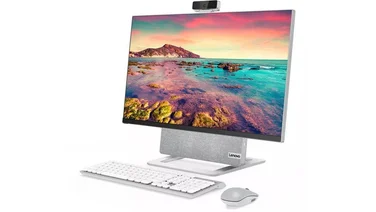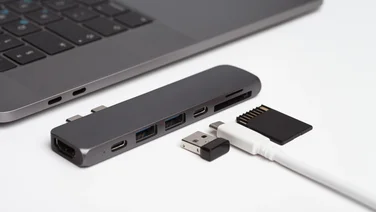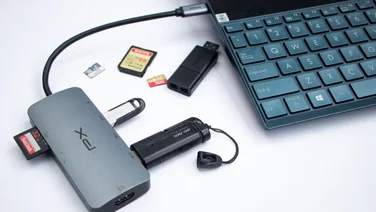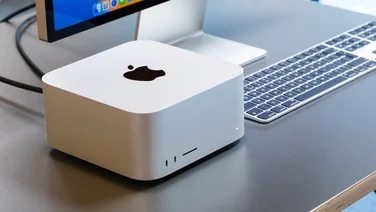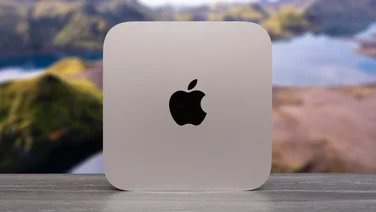To help us provide you with free impartial advice, we may earn a commission if you buy through links on our site. Learn more






- Still attractive
- Fast CPU and graphics
- Magnificent 4K Retina display
- Base model comes with a regular HDD
- Big fat bezels
“If it ain’t broke, don’t fix it” seems to be the mantra for Apple at the moment – certainly that’s the impression you get if you look at the 2019 update to the firm’s iMac all-in-one PCs. The 21-inch iMac (2019) is packaged in the same chassis it has used since 2012. Back then, the iMac was at the cutting edge of PC design; today, it’s still great but the design could do with a bit of an update.
READ NEXT: Apple Mac Mini (2018) review – a welcome upgrade at an unwelcome price
Apple 21.5-inch iMac review: What you need to know
In fact, the only thing that has changed since 2012 are the ports at the rear of the 21in iMac, the specifications of the display and the internals. This year, however, is significant for the smaller of Apple’s all-in-one PCs: this model is the first to be available with a six-core Intel processor and the first with discrete graphics power.
As a result, the 2019 21.5in iMac Pro is the fastest, most powerful iMac 21.5in yet. It packs a huge punch for such a compact machine and, despite the ageing chassis, it’s still the most elegant desktop PC you can buy.
Apple 21.5-inch iMac review: Prices and configurations
As ever with Apple’s iMacs, you can configure the machine to your own specifications. We’ve been sent the upper spec base model with a 3GHz six-core Core i5 CPU, 8GB of RAM, an AMD Radeon Pro 560X GPU and a 1TB Fusion Drive. This will set you back £1,445 with prices rising to a maximum of £3,114 for the model with a 3.2GHz six-core Core i7, 32GB of RAM and a 1TB SSD.
The other new suggested configuration starts at £1,249 and comes with a 3.6GHz quad-core Core i3 CPU, 8GB of RAM, an AMD Radeon Pro 555X GPU and a 1TB standard hard disk. You can bump this up to £2,779 by upgrading the CPU, RAM and storage in the same way as above, the only difference between the models being the GPU. Both new configurations come with Apple’s 4K wide-gamut DCI-P3 display.
The older-specification 1080p 21.5in iMac is still available for those who can’t quite stretch to the new models. It costs from £1,049 and comes with a dual-core 2.3GHz Core i5, 8GB of RAM, integrated Intel Iris Plus Graphics 640 and a 1TB standard hard disk.
All-in-one PCs isn’t a category of product we review particularly frequently. They come along in dribs and drabs and the ones we’ve looked at recently – the Microsoft Surface Studio 2 and the iMac Pro – have been at the more expensive end of the price spectrum.
HP is making some interesting-looking rivals in this bracket, notably the HP Pavilion 24-xa0016na. This comes with a six-core 2.4GHz Intel Core i7-8700T, 8GB of RAM, a huge 2TB hard disk and costs £1,250. It only comes with a 1080p display, though.
Apple 21.5-inch iMac review: Features and design
That puts the Apple 21.5-inch iMac in a unique position. It’s the only serious all-in-one of its size with such a sharp display, and certainly the only one this powerful. If the looks, the size, the features and performance all appeal, it’s the best option for you.
So, what do you get for your £1,445? First and foremost, you’re getting the best-looking all-in-one in the market. Its chassis is constructed from aluminium and finished in an attractive matte silver and, from most angles, the display unit looks like it’s floating in space, suspended in front of you.
It isn’t, of course, but the L-shaped stand – also constructed from chiselled aluminium – certainly makes it seem that way, as does the way the rear of the iMac tapers elegantly towards all of its edges. Only when you look at it from the side does the bulge housing all the iMac’s components become apparent. The iMac’s minimalism, as ever, also stretches to the positioning of its ports.






If you want to connect anything physically to the iMac you’ll have to fumble around at the rear of the iMac on the right-hand side, where you’ll find four USB 3 ports, two Thunderbolt 3 USB Type-C sockets, a Gigabit Ethernet port, SDXC card slot and 3.5mm headset jack. Even the speakers are hidden away, with sound emanating from grilles cut discreetly into the narrow bottom edge beneath the screen.
For all that it hasn’t been updated for seven years, though, the iMac wears its age wonderfully well. It’s still the only computer businesses who want to look smart and modern will consider putting on public display and for anyone kitting out a minimalist modern home, it’s the desktop computer that will look least out of place.
The one thing that grates is that, in 2019, those thick black bezels surrounding the display are beginning to look dated. It’s high time that Apple got rid of them entirely or at least reduced them in thickness considerably. Maybe next time.






Apple 21.5-inch iMac review: Display
The 4K screen contained within those bezels, however, is unimpeachable. Specifically, it has a resolution of 4,096 x 2,340 pixels and, as with recent iMacs, the display is a wide-gamut display, capable of reproducing colours across the DCI-P3 colour space – similar to that implemented in HDR TVs.
Technically, it’s rather good. With the iMac’s default colour profile selected, I used the Expert Reviews’ colorimeter to check colour accuracy and gamut coverage using the open-source DisplayCal software and found the 21.5in iMac’s screen to be impeccably calibrated. In tests, it covered 98.3% of the DCI-P3 colour gamut and colour accuracy in the same colour space was fantastic. I recorded an average colour difference value (Delta E) of 0.61, which is as accurate as monitors get, even at the professional level of the scale.
As for brightness, that was fine, reaching a peak of 517cd/², although the contrast ratio was down at 571:1, which is surprisingly low for an otherwise high-spec display.






Apple 21.5-inch iMac review: Performance
The real substance behind this iMac refresh, however, lies in the new CPUs and GPU selections, which offer a significant bump up in performance. The new CPU options include the quad-core Intel Core i3 chips or, better still, the six-core Core i5 and Core i7 parts.
The one I’ve tested here is the six-core Core i5-8700T (a low-power desktop chip) running at a base frequency of 3GHz (with a max Turbo Boost of 4GHz) and it’s backed up by 8GB of DDR4 RAM. It’s a seriously quick machine that’s capable of outmuscling even the Core i9 15in MacBook Pro, at least in our in-house 4K media benchmarks.

In GeekBench, the difference is reversed, with the 21.5in iMac matching the MacBook for single-threaded oomph but lagging slightly behind on multitasking, although it’s a clear step up from the new Mac Mini (late 2018). Clearly, it’s no match for the iMac Pro but what’s surprising is that it isn’t far off when it comes to single-threaded performance.

The weak link, at least with the review model I was sent, is storage. This configuration of iMac comes with a 1TB Apple Fusion drive, which consists of a 2.5in 5,400rpm Hitachi Travelstar hard disk mated to 32GB of flash storage for caching commonly used files. The cheaper new model doesn’t even have a Fusion drive – it has a plain old 1TB hard disk.
In day-to-day use, the Fusion Drive in my review model feels nippy enough most of the time but there are times when it slows you down, almost stopping you in your tracks. The first time you launch a hefty app or game, for instance, can take an age. It’s clearly far from the fastest hardware Apple could (and arguably should) have chosen to include. With SSD prices falling all the time, Apple’s insistence on including any form of mechanical disk in its premium desktops is baffling.
For me, there simply is no reason today to specify anything but an SSD in a top-end all-in-one like this, especially since you can pick up 1TB SATA SSDs from as little as £100 and 1TB PCIe drives for around £200.
Moreover, the premium Apple is currently charging to upgrade to high-capacity SSD is beyond unreasonable. If, at the point of sale, you were to choose to replace the 1TB Fusion Drive inside this iMac with a 1TB SSD, that upgrade would cost you £630 extra. For that reason, I suggest you stick with the 256GB SSD upgrade, which is a much more reasonable £90 extra and well worth the drop in capacity for the increase in overall performance you’ll get.
Apple 21.5-inch iMac review: Verdict
That makes the updated 21.5in iMac a tricky machine to pigeonhole. On the one hand, its performance is great, that display is superb it remains a classic design; on the other hand, the iMac REALLY needs to come with an SSD as standard and the chassis could do with a little modernisation.
If you really want an iMac, though – and I completely understand if you do – it’s not a terrible choice at all. It’s fast enough to take care of any task you care to throw at it and attractive enough to grace any environment, from a five-star hotel reception to minimalist London bachelor pad. Just make sure you avoid the 1TB Fusion Drive model and specify the 256GB SSD model instead.

